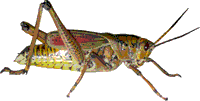Entomology Collections, General

Entomology Papers from Other Sources
Document Type
Article
Date of this Version
6-1982
Citation
Prairie Naturalist (June 1982) 14(2): 37-45.
Abstract
Grasshoppers (Orthoptera: Acrididae) represent a conspicuous and often important component of grassland systems (Odum et al. 1962, Smalley 1960, Sinclair 1975, Van Hook 1971, Wiegert 1965). Often, assemblages of grasshoppers are quite diverse and may, on occasion, consume a large fraction of the available vegetation (Hewitt 1977, Hewitt et al. 1976, Mitchell and pfadt 1974). As such, grasshoppers have the potential of being very important in the nutrient and energy flow in grassland ecosystems. However, to understand the impact of grasshoppers at the ecosystem level requires that the densities and fluctuations of populations as well as the species composition of entire assemblages be understood. The present study presents such background for an assemblage of grasshoppers located in the sandhills prairie of Nebraska. These results were obtained during a period when grasshopper abundances in the region were high enough for extensive chemical control efforts and the years just following this peak; the present study area was not sprayed, however.
The grasshopper fauna at Arapaho Prairie is diverse and includes species from four subfamilies. These species exhibit a wide range of feeding behaviors and life history traits (Joern, unpublished). Data on the abundances of these grasshoppers permit the evaluation of several specific questions including: 1) What trends are seen in the densities and the relative abundances of particular species shortly after periods of high densities when no chemical control is employed? 2) Are different sites in a sandhills prairie, each dominated by different species of plants, inhabited by the same or different species of grasshoppers? 3) What are the patterns of relative abundances of species? and 4) What is the effect of disturbance of the habitat on the composition of the specific taxa and abundances of grasshoppers?
Included in
Biodiversity Commons, Entomology Commons, Population Biology Commons, Terrestrial and Aquatic Ecology Commons


Comments
Copyright 1982, North Dakota Natural Science Society. Used by permission.